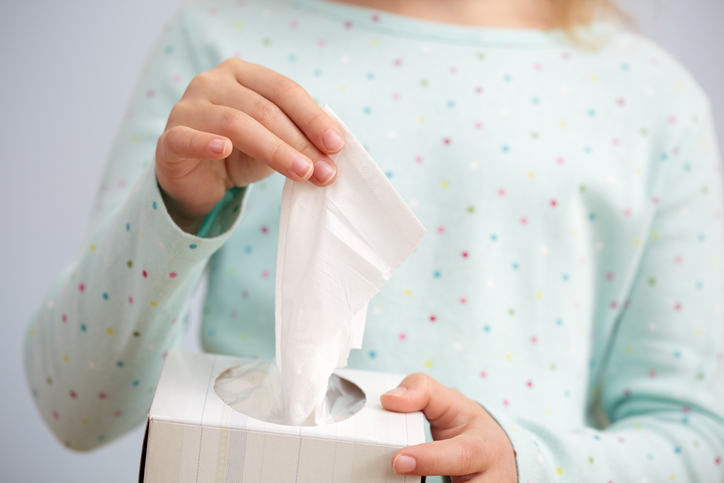
iStock
CONQUERING CONSTANT nonallergic sniffles may require as little as eating a very spicy meal every few months—or, for anyone with a sensitive stomach, capsaicin nasal sprays can do the trick with effects lasting up to six months.
(In the face of the corona virus pandemic, sniffles are not a common symptom of Covid-19 but can appear worrisome to others; also, a runny nose is difficult to manage beneath a mask.)
Sniffles that occur in the absence of infection or allergies—also called chronic idiopathic (no known cause) rhinitis —affect some 7% of the population but may be responsible for between 17 and 52% of seasonal allergy-like symptoms,” according to Consumer Reports. These symptoms are more likely to include a stuffy or runny nose and postnasal drip—but usually not the itchy nose or eyes, or scratchy throat of allergy sufferers—and, for many sufferers, have no seasonal pattern.
Problems of the aging nose are the focus of most news features on nonallergic sniffles (including a recent Washington Post Health section summary of the Consumer Reports article)—despite a comprehensive paper highlighting two alternative causes but appearing ten years ago in the Proceedings of the American Thoracic Society.
While aging nose issues respond well to moisturizing with saline or steam, the other two conditions—localized allergic disease and nasal hyperreactivity—do better with nasal sprays containing capsaicin, anti-inflammatory steroids or antihistamines.
“There has not been enough effort in the medical and scientific communities to address nonallergic rhinitis which, indeed, affects many people,” wrote allergist Alkis Togias, branch chief at the National Institute of Asthma and Infectious Diseases and co-author of the Proceedings article, in an email to mylittlebird. “Very few people are working in this field.”
The historic classification of chronic rhinitis into allergic rhinitis and non-allergic, non-infectious rhinitis “does not reflect the complexity of the rhinitis syndrome,” according to Spanish researchers who investigated the local allergic condition.
Local allergic rhinitis (LAR) involves a low-level sensitivity to allergens that affects only the nasal mucosa—in contrast to the body-wide response of allergy sufferers. Also, while histamine plays a role in allergy sufferers’ symptoms, local inflammation in those with LAR involves different cells, eosinophils, produced by the immune system.
For the other alternative, nasal hyperreactivity, there is no inflammation but sufferers appear hyperresponsive to cold air and spicy food. Also called vasomotor rhinitis (VMR), “motor” refers to nerves that in this case are “unusually sensitive to irritation.”
VMR can include “gustatory rhinitis,” which follows the consumption of hot and spicy foods, according to the Asthma Foundation.
Capsaicin falls into the category of nasal irritants but produces mild irritation that can lead to a long-lasting improvement of symptoms. Used twice daily for two weeks, capsaicin nasal spray produced “dramatic improvement in most cases of nonallergic rhinitis symptoms” compared to a placebo in research at the University of Cincinnati.
Treatment with capsaicin— extracted from hot chili peppers and also used for its ability to interrupt pain signals —calms sensory fibers in the nose, which leads to prolonged improvement in reactivity and in turn reduces nasal responsiveness to cold air.
For everyone, cold air in the nose can induce significant water loss, causing the body to constantly replenish moisture, which in turn produces a runny nose—in wintertime called “skier’s nose.” Providing added moisture from steamy baths or humidifiers can reduce or stop the sniffles for many people.
Dryness is also the main cause of sniffling that worsens with age, due to a decrease in body water; degeneration of mucus-secreting glands and reduced effectiveness of the mucus in clearing out nasal passages; and decrease in nasal blood flow that leads to drying of the membranes.
Saline nasal irritation is the most common recommendation to replace moisture—using a neti pot or bulb syringe —although hot steam inhalation and hot baths can be more appealing.
Among over-the-counter nasal sprays, capsaicin sprays such as Sinus Plumber ($25.95 for 2-pack) can help with nasal hyperreactivity; while Flonase ($38.90 for 2-pack) can help with localized allergic reaction.
Evaluation by a medical professional can rule out systemic allergies; also, the antihistamine azelastine, which works well for some nonallergic cases, is available only by prescription. Alternatively, to investigate potential causes for sniffles unrelated to infection, allergies or aging, experimenting with different OTC treatments might be the easiest route.
—Mary Carpenter
Every Tuesday, well-being editor Mary Carpenter delivers health news you can use.
